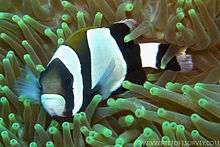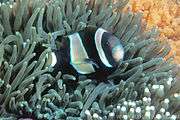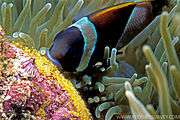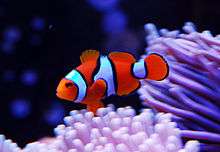Amphiprion latezonatus
Amphiprion latezonatus, also known as the wide-band anemonefish, is a species of anemonefish found in subtropical waters off the east coast of Australia.[1][2] Like all anemonefishes, it forms a symbiotic mutualism with sea anemones and is unaffected by the stinging tentacles of its host. It is a sequential hermaphrodite with a strict size-based dominance hierarchy; the female is largest, the breeding male is second largest, and the male nonbreeders get progressively smaller as the hierarchy descends.[3] They exhibit protandry, meaning the breeding male changes to female if the sole breeding female dies, with the largest nonbreeder becoming the breeding male.[1]
| Amphiprion latezonatus | |
|---|---|
 | |
| Scientific classification | |
| Kingdom: | Animalia |
| Phylum: | Chordata |
| Class: | Actinopterygii |
| Family: | Pomacentridae |
| Genus: | Amphiprion |
| Species: | A. latezonatus |
| Binomial name | |
| Amphiprion latezonatus Waite, 1900 | |
Description
A. latezonatus grows to 14 cm (5 1⁄2 in)[1][2] and is dark brown with three white bars and a broad white margin on the caudal fin. As the common name suggests, the middle bar is very wide, about twice the average width of other anemonefishes and is shaped like a flat-topped pyramid.[1] They have 10 dorsal spines, two anal spines, 15–16 dorsal soft rays, and 13–14 anal soft rays.[2]
Color variations
A. latezonatus often has bright blue markings on the upper lip and the edges of the bars. The dorsal fin may be orange or yellow[1]
 A. latezonatus showing blue markings
A. latezonatus showing blue markings A. latezonatus showing orange dorsal fin
A. latezonatus showing orange dorsal fin
Similar species
The broad midbody bar is distinctive, and A. latezonatus is unlikely to be confused with any other anemonefish.[1] The closest in appearance are A. polymnus (saddleback anemonefish) and A. sebae (sebae anemonefish), but A. latezonatus has a broader midband and lacks the characteristic slope of A. polymnus or A. sebae. Historically, anemonefish have been identified by morphological features and color pattern in the field, while in a laboratory, other features such as scalation of the head, tooth shape, and body proportions are used.[1] These features have been used to group species into complexes, and A. latezonatus was considered as part of the saddleback complex with A. polymnus and A. sebae.[4] Genetic analysis has shown that the saddleback complex is not a monophyletic group and that A. latezonatus has a monospecific lineage,[5] and is more closely related to A. percula and Premnas biaculeatus than to the saddleback group.[5][6]
- A. polymnus (saddleback anemonefish)
- A. sebae (sebae anemonefish)
 The genetically related A. percula (clownfish)
The genetically related A. percula (clownfish).jpg) The genetically related Premnas biaculeatus (maroon or spine-cheeked anemonefish)
The genetically related Premnas biaculeatus (maroon or spine-cheeked anemonefish)
Distribution and habitat
A. latezonatus is found in subtropical waters of Australia, from southern Queensland to northern New South Wales, Norfolk Island, and Lord Howe Island.[1]
Host anemones
The relationship between anemonefish and their host sea anemones is not random and instead is highly nested in structure.[7] A. latezonatus is highly specialised with only one species anemone host, Heteractis crispa (sebae anemone).[1] A. latezonatus has been found in two additional host sea anemone species.[8]
Conservation status
Anemonefish and their host anemones are found on coral reefs and face similar environmental issues. Like corals, anemone's contain intracellular endosymbionts, zooxanthellae, and can suffer from bleaching due to triggers such as increased water temperature or acidification. Characteristics known to elevate the risk of extinction are small geographic range, small local population, and extreme habitat specialisation.[9][10] A. latezonatus is an endemic species, confined to the subtropical east coast of Australia. The finding of A. latezonatus being hosted by two additional sea anemone species [8] may reduce the risk of extinction associated with specialisation.[11] This species was not evaluated in the 2012 release of the IUCN Red List
In aquaria
A. latezonatus has been bred in captivity.[12]
References
- Fautin, Daphne G.; Allen, Gerald R. (1997). Field Guide to Anemone Fishes and Their Host Sea Anemones. Western Australian Museum. ISBN 9780730983651. Archived from the original on 18 October 2014.
- Froese, Rainer and Pauly, Daniel, eds. (2019). "Amphiprion latezonatus" in FishBase. February 2019 version.
- Buston PM (May 2004). "Territory inheritance in clownfish". Proceedings of the Royal Society B: Biological Sciences. 271 (Suppl 4): S252–S254. doi:10.1098/rsbl.2003.0156. PMC 1810038. PMID 15252999.
- Goemans, B. "Anemonefishes". Retrieved 20 September 2015.
- Litsios, G.; Sims, C.; Wüest, R.; Pearman P.B.; Zimmermann, N.E.; Salamin N. (2012). "Mutualism with sea anemones triggered the adaptive radiation of clownfishes". BMC Evolutionary Biology. 12 (11): 212. doi:10.1186/1471-2148-12-212. PMC 3532366. PMID 23122007.
- DeAngelis, R. "What we really know about the diversity of Clownfish". Archived from the original on 25 September 2015. Retrieved 20 September 2015.
- Ollerton J; McCollin D; Fautin DG; Allen GR (2007). "Finding NEMO: nestedness engendered by mutualistic organization in anemonefish and their hosts". Proceedings of the Royal Society B: Biological Sciences. 274 (1609): 591–598. doi:10.1098/rspb.2006.3758. PMC 1766375. PMID 17476781.
- Scott, A.; Rushworth, K.J.W.; Dalton, S.J.; Smith, S.D.A. (2016). "Subtropical anemonefish Amphiprion latezonatus recorded in two additional host sea anemone species". Marine Biodiversity. 46 (2): 327–328. doi:10.1007/s12526-015-0390-0.
- Munday P.L. (2004). "Habitat loss, resource specialization, and extinction on coral reefs". Global Change Biology. 10 (10): 1642–1647. Bibcode:2004GCBio..10.1642M. doi:10.1111/j.1365-2486.2004.00839.x.
- Hobbs J.-P.A.; Frisch A.J.; Ford B.M.; Thums M.; Saenz-Agudelo P.; Furby K.A.; Berumen M.L. (August 2013). "Taxonomic, spatial and temporal patterns of bleaching in anemones inhabited by anemonefishes". PLoS ONE. 8 (8): e70966. Bibcode:2013PLoSO...870966H. doi:10.1371/journal.pone.0070966. PMC 3738586. PMID 23951056.
- Hobbs J.-P.A.; Beger, M.; De Brauwer, M.; Emslie, M.J. (September 2014). "North-eastern range extension of the anemone Stichodactyla haddoni to the Marshall Islands represents a new record of host use by the endemic anemonefish Amphiprion tricinctus". Marine Biodiversity Records. 7: e106. doi:10.1017/S1755267214001055.
- Bray, R.D.; Bray, D.J. (2011). "Wideband Anemonefish, Amphiprion latezonatus". Fishes of Australia. Archived from the original on 24 May 2015. Retrieved 20 Sep 2015.
External links
| Wikimedia Commons has media related to Amphiprion latezonatus. |
| Wikispecies has information related to Amphiprion latezonatus |
- "Amphiprion latezonatus". Integrated Taxonomic Information System.
- Amphiprion latezonatus. Waite, 1900. Retrieved through: World Register of Marine Species.